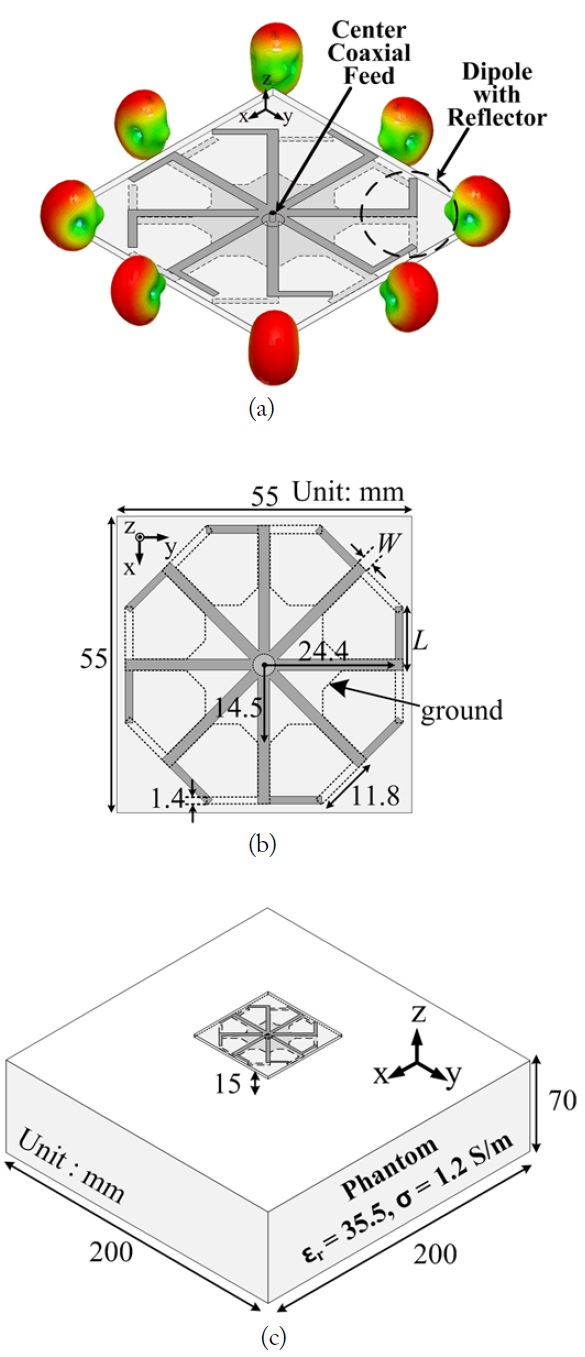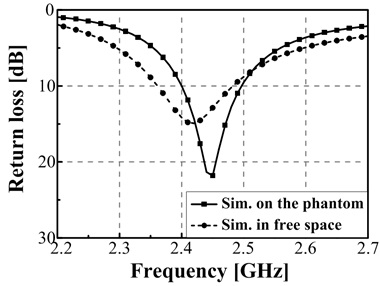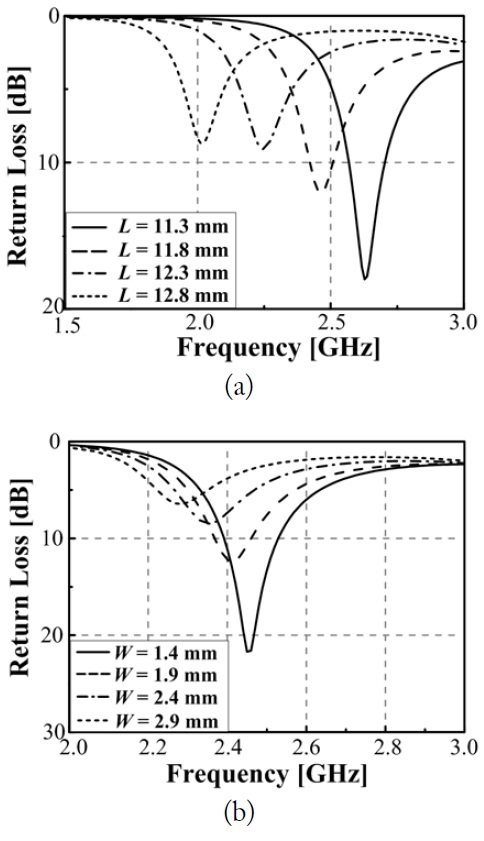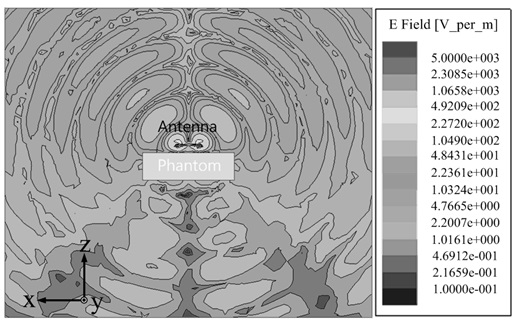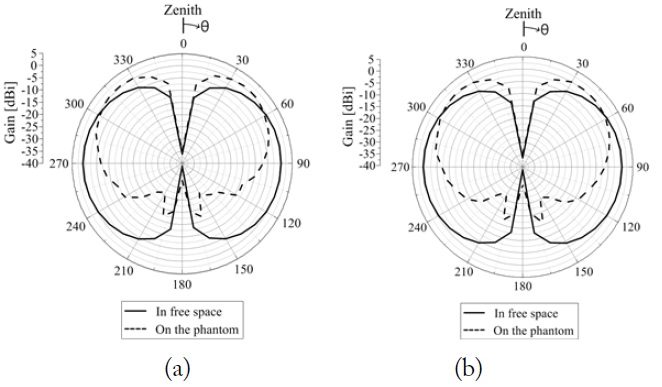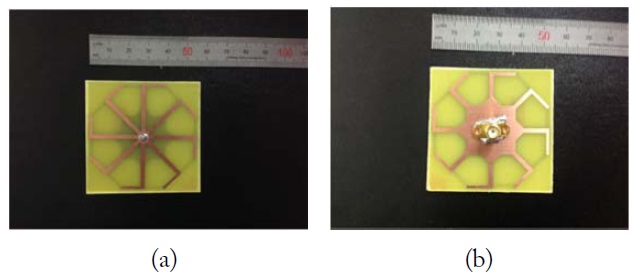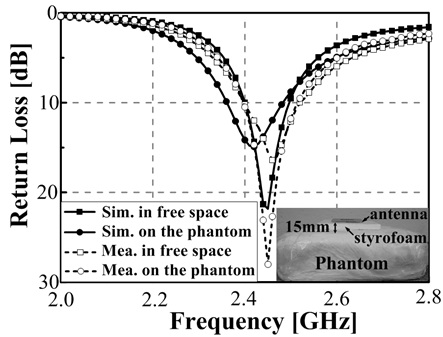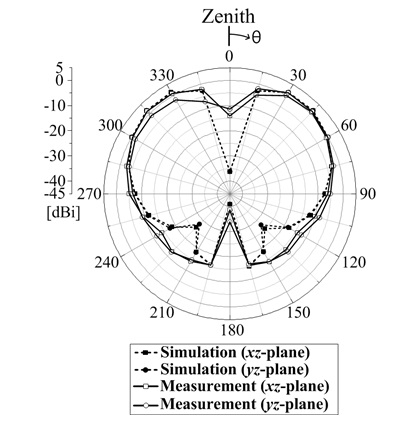



Wireless body area network (WBAN) has recently received great attention due to its applicability in various services. Depending on the location of the transceiver on the human body, a WBAN system can be categorized as off-body, on-body, or inbody [1]. The radiation characteristics of an antenna for a WBAN system are particularly important in establishing a successful communications link between the transceivers. In order to establish a good on-body communication channel between two on-body devices, an antenna is required to have radiation characteristics similar to those of a vertical monopole antenna. However, a monopole antenna is not suitable for on-body communications, due to its large vertical size. Therefore, a lowprofile antenna with monopole-like radiation characteristics is necessary for on-body communication. In order to obtain a lowprofile antenna with a monopole-like radiation pattern, various types of antennas have been proposed [2-10]. Dielectric resonator antenna types for monopole-like radiation characteri-stics were published in [2, 3]; however, the vertical size of those antennas is too large for use in on-body devices. In [4], an Alford loop antenna for surface-wave generation was proposed, but the Alford loop antenna is not suitable for on-body communications because its performance is substantially affected by the human body environment.
In order to realize a low-profile antenna with a monopolelike radiation pattern, several types of patch antennas using various resonance modes have been proposed [5-10]. In [5], a microstrip monopolar patch antenna using TM01 and TM02 resonance modes for monopole-like radiation characteristics was suggested. A circular patch-ring antenna with TM02 mode was proposed in [6]. TM01 and TM02 mode antennas have greater gain than higher-order mode (TM21, TM41) antennas. However, the antennas should be large for on-body devices. Rectangular patch antennas using the TM21 mode were introduced in [7, 8]. Generally, the TM21 mode antenna is smaller than TM01, 02, 41 antennas. However, TM01, 02, 41 mode antennas generate a radiation pattern that is closer to omnidirectional compared to that of a TM21 mode antenna. TM41 mode antennas have a higher maximum radiation angle from the zenith than TM21 mode antennas [9, 10].
In this paper, a low-profile dipole array antenna with a monopole-like radiation pattern for on-body communications is proposed. The antenna operates in the 2.45 GHz industrial, scientific, and medical (ISM) band with omnidirectional radiation characteristics. The performance of the proposed antenna is verified both numerically and experimentally when it is attached to a two-thirds muscle-equivalent semi-solid phantom.
Fig. 1(a) and (b) show the structure of the dipole array antenna. The proposed antenna, with dimensions of 55 mm × 55 mm × 1.6 mm (0.44 λ0 × 0.44 λ0 × 0.013 λ0 at 2.45 GHz), is designed on a FR-4 (ε
Fig. 2 shows the comparison between the simulated return loss characteristics of the proposed antenna in free space and on the phantom. Due to the human body effect, the resonance frequency shifts slightly to the higher frequency side, and the bandwidth is decreased. The 10-dB return loss bandwidth was 4.1% (2.39–2.49 GHz) in the 2.45 GHz ISM band (2.4–2.485 GHz).
Fig. 3(a) and (b) show the simulated return loss characteristics for various design parameters. As the dipole length
Fig. 4 shows the simulated electric field magnitude distribution of the antenna on the phantom in the xz-plane at 2.45 GHz. The proposed antenna is suitable for on-body communications due to the similarity of its radiation pattern to that of a vertical monopole antenna.
Fig. 5(a) and (b) show the simulated far-field radiation patterns of the proposed antenna in free space and those of the phantom at 2.45 GHz in the xz-plane and in the yz-plane, respectively. The minimum radiation of the proposed antenna is at θ = 0° and the maximum radiation is at θ = 50°. The simulated realized peak gains of the proposed antenna in free space and on the phantom are 0.5 dBi and 0.8 dBi, respectively. Due to the reflection from the phantom, the peak gain of the proposed antenna on the phantom is higher than the peak gain in free space. The total radiation efficiencies of the proposed antenna without and with the phantom are 84.3% and 34.06%, respectively. The simulation results of this work were obtained by High Frequency Structure Simulator (HFSS) v.14.0.0 (ANSYS Inc., Canonsburg, PA, USA).
Fig. 6 shows the top and bottom view of the manufactured antenna. The antenna was fabricated on a FR-4 (ε
Fig. 7 shows the simulated and measured return loss cha-racteristics of the proposed antenna. To analyze the antenna performance experimentally, a two-thirds muscle-equivalent semi-solid phantom (ε
Fig. 8 shows the simulated and measured far-field radiation patterns of the proposed antenna on the phantom at 2.45 GHz in the E-plane and the H-plane. The measurement results agree reasonably well with the simulation. The minimum radiation of the fabricated antenna is in the direction normal to the phantom surface (zenith direction), and the maximum radiation is at θ = 50°. The measured peak gain of the proposed antenna on the phantom in the E- and H-planes is 0.4 dBi.
Table 1 shows the comparison of the size of the proposed antenna and those of the reference antennas with monopolelike radiation. It is observed that the proposed antenna is well designed for its compact size.
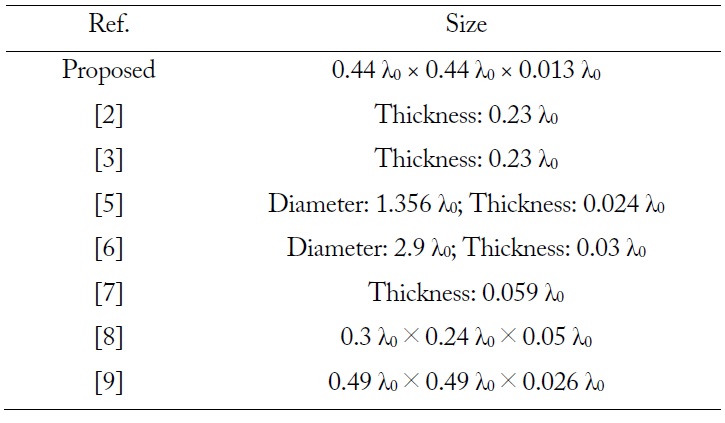
Comparison between the size of the proposed antenna and those of the reference antennas with monopole-like radiation
In this paper, a low-profile dipole array antenna with a monopole-like radiation pattern for WBAN on-body communications applications is proposed. The bandwidth of the proposed antenna can cover the 2.45 GHz ISM band (2.4–2.485 GHz) fully while maintaining a low-profile configuration with a height of only 0.013 λ0 at 2.45 GHz. To obtain a monopolelike radiation pattern with a low profile, eight dipole elements were placed symmetrically around the
